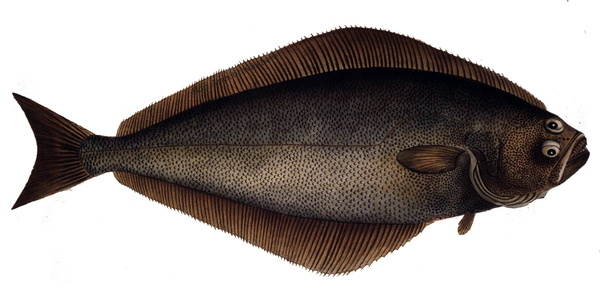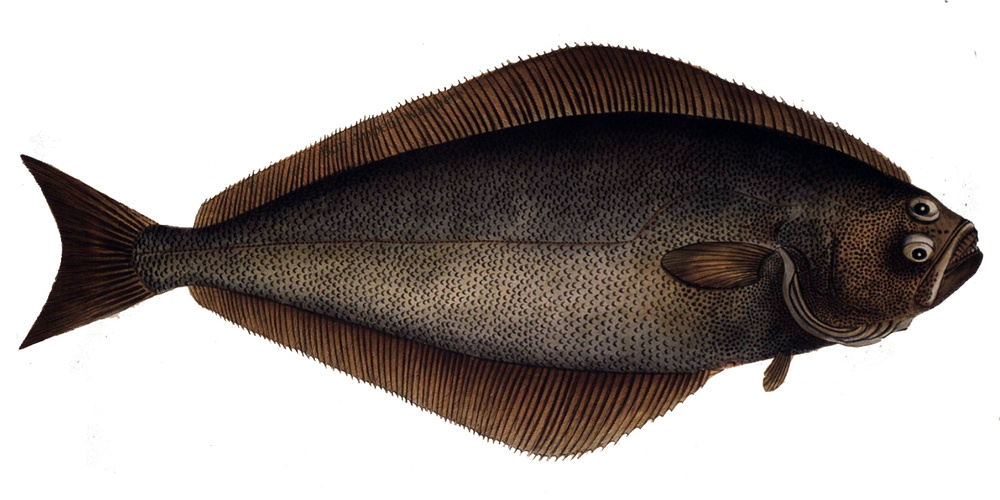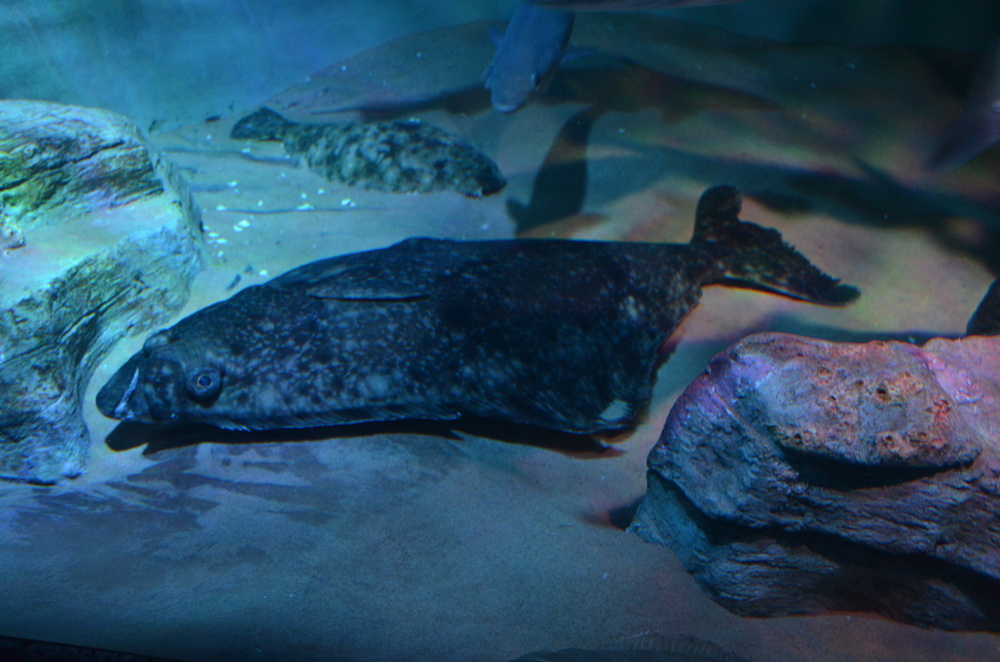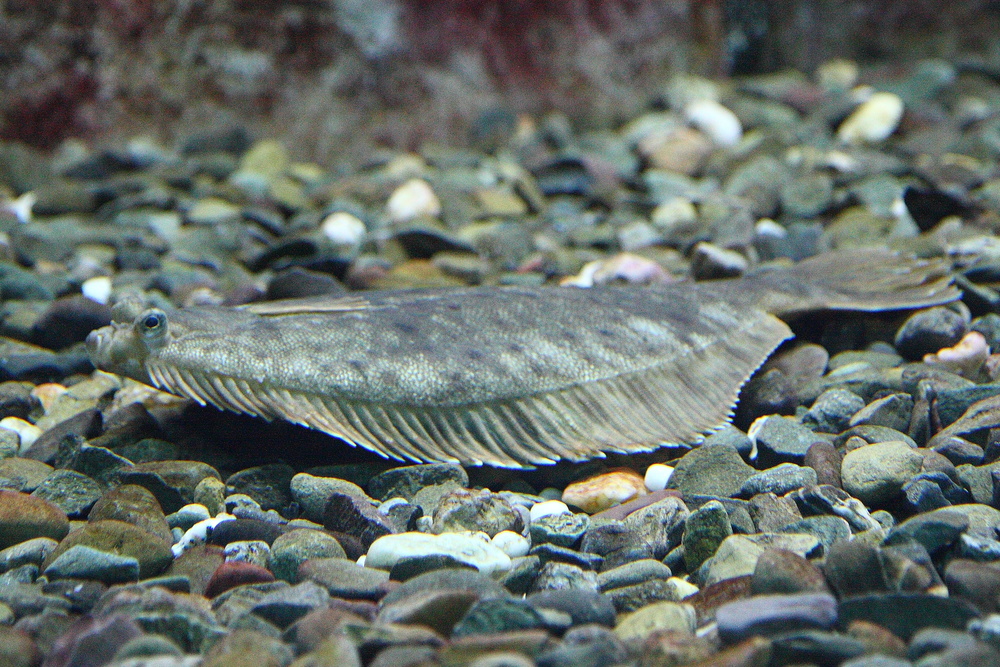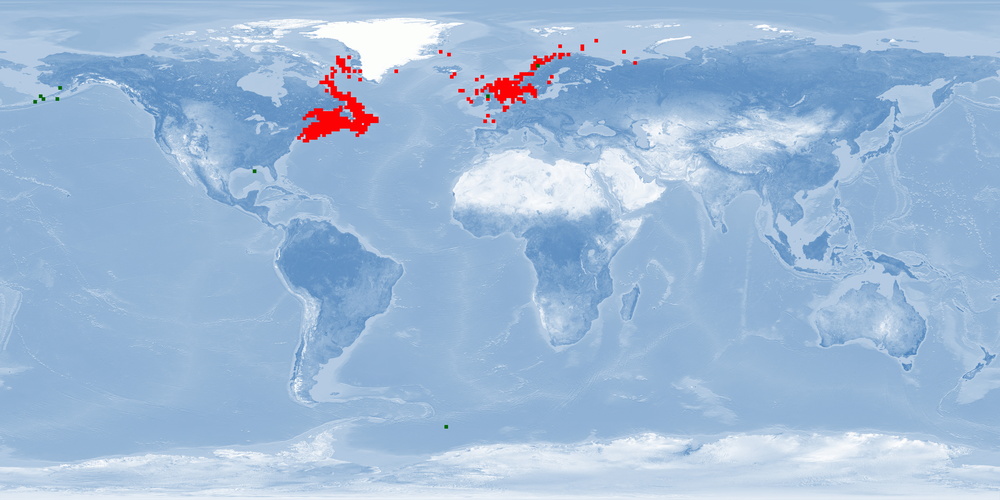Information
Version: B | 1.1 (2022-06-23)
Please note: This part of the profile is currently being revised.
WelfareScore | farm
Condensed assessment of the species' likelihood and potential for good fish welfare in aquaculture, based on ethological findings for 10 crucial criteria.
- Li = Likelihood that the individuals of the species experience good welfare under minimal farming conditions
- Po = Potential of the individuals of the species to experience good welfare under high-standard farming conditions
- Ce = Certainty of our findings in Likelihood and Potential
WelfareScore = Sum of criteria scoring "High" (max. 10)
General remarks
Hippoglossus hippoglossus is a slow growing, cold water flatfish that can reach up to nearly 5 m and over 300 kg. It is endangered due to overfishing. It has a high market value, hence it has been in the focus of the aquaculture industry. However, its particular biology and life history makes this species inadequate to be farmed in welfare. Namely, its home and depth ranges are far greater than any method can satisfy, its reproduction is still largely dependent on invasive induction, it displays aggressive behaviour, requires specific shelter and substrate, and is very sensitive to common farming procedures. In addition due to its slow growth it requires many years of investment, and the metamorphosis in early stages demands extra good rearing conditions in order to produce healthy individuals. Potential for improvement lies principally in providing better conditions for non-induced spawning and proper feeding regimes to avoid aggression.
1 Home range
Many species traverse in a limited horizontal space (even if just for a certain period of time per year); the home range may be described as a species' understanding of its environment (i.e., its cognitive map) for the most important resources it needs access to.
What is the probability of providing the species' whole home range in captivity?
It is low for minimal and high-standard farming conditions. Our conclusion is based on a high amount of evidence.


2 Depth range
Given the availability of resources (food, shelter) or the need to avoid predators, species spend their time within a certain depth range.
What is the probability of providing the species' whole depth range in captivity?
It is low for minimal and high-standard farming conditions. Our conclusion is based on a high amount of evidence.


3 Migration
Some species undergo seasonal changes of environments for different purposes (feeding, spawning, etc.), and to move there, they migrate for more or less extensive distances.
What is the probability of providing farming conditions that are compatible with the migrating or habitat-changing behaviour of the species?
It is low for minimal and high-standard farming conditions. Our conclusion is based on a medium amount of evidence.


4 Reproduction
A species reproduces at a certain age, season, and sex ratio and possibly involving courtship rituals.
What is the probability of the species reproducing naturally in captivity without manipulation of theses circumstances?
It is low for minimal farming conditions. It is medium for high-standard farming conditions. Our conclusion is based on a high amount of evidence.


5 Aggregation
Species differ in the way they co-exist with conspecifics or other species from being solitary to aggregating unstructured, casually roaming in shoals or closely coordinating in schools of varying densities.
What is the probability of providing farming conditions that are compatible with the aggregation behaviour of the species?
It is low for minimal and high-standard farming conditions. Our conclusion is based on a high amount of evidence.


6 Aggression
There is a range of adverse reactions in species, spanning from being relatively indifferent towards others to defending valuable resources (e.g., food, territory, mates) to actively attacking opponents.
What is the probability of the species being non-aggressive and non-territorial in captivity?
It is low for minimal farming conditions. It is medium for high-standard farming conditions. Our conclusion is based on a low amount of evidence.


7 Substrate
Depending on where in the water column the species lives, it differs in interacting with or relying on various substrates for feeding or covering purposes (e.g., plants, rocks and stones, sand and mud).
What is the probability of providing the species' substrate and shelter needs in captivity?
It is low for minimal farming conditions. It is medium for high-standard farming conditions. Our conclusion is based on a high amount of evidence.


8 Stress
Farming involves subjecting the species to diverse procedures (e.g., handling, air exposure, short-term confinement, short-term crowding, transport), sudden parameter changes or repeated disturbances (e.g., husbandry, size-grading).
What is the probability of the species not being stressed?
It is low for minimal farming conditions. It is medium for high-standard farming conditions. Our conclusion is based on a medium amount of evidence.


9 Malformations
Deformities that – in contrast to diseases – are commonly irreversible may indicate sub-optimal rearing conditions (e.g., mechanical stress during hatching and rearing, environmental factors unless mentioned in crit. 3, aquatic pollutants, nutritional deficiencies) or a general incompatibility of the species with being farmed.
What is the probability of the species being malformed rarely?
It is low for minimal farming conditions. It is medium for high-standard farming conditions. Our conclusion is based on a medium amount of evidence.


10 Slaughter
The cornerstone for a humane treatment is that slaughter a) immediately follows stunning (i.e., while the individual is unconscious), b) happens according to a clear and reproducible set of instructions verified under farming conditions, and c) avoids pain, suffering, and distress.
What is the probability of the species being slaughtered according to a humane slaughter protocol?
It is low for minimal farming conditions. It is medium for high-standard farming conditions. Our conclusion is based on a medium amount of evidence.


Side note: Domestication
Teletchea and Fontaine introduced 5 domestication levels illustrating how far species are from having their life cycle closed in captivity without wild input, how long they have been reared in captivity, and whether breeding programmes are in place.
What is the species’ domestication level?
DOMESTICATION LEVEL 3 35, level 5 being fully domesticated.
Side note: Forage fish in the feed
450-1,000 milliard wild-caught fishes end up being processed into fish meal and fish oil each year which contributes to overfishing and represents enormous suffering. There is a broad range of feeding types within species reared in captivity.
To what degree may fish meal and fish oil based on forage fish be replaced by non-forage fishery components (e.g., poultry blood meal) or sustainable sources (e.g., soybean cake)?
All age classes: WILD: Carnivorous 2. FARM: Fish meal may be partly* replaced by non-forage fishery components 36 37 38.
*partly = <51% – mostly = 51-99% – completely = 100%
Glossary
BENTHIC = living at the bottom of a body of water, able to rest on the floor
DOMESTICATION LEVEL 3 = entire life cycle closed in captivity with wild inputs 35
FARM = setting in farming environment or under conditions simulating farming environment in terms of size of facility or number of individuals
JUVENILES = fully developed but immature individuals, for details ➝ Findings 10.1 Ontogenetic development
LAB = setting in laboratory environment
LARVAE = hatching to mouth opening, for details ➝ Findings 10.1 Ontogenetic development
OCEANODROMOUS = living and migrating in the sea
PELAGIC = living independent of bottom and shore of a body of water
SPAWNERS = adults during the spawning season; in farms: adults that are kept as broodstock
WILD = setting in the wild
Bibliography
2 Haug, Tore. 1990. Biology of the Atlantic Halibut, Hippoglossus hippoglossus (L., 1758). Advances in Marine Biology 26: 1–70. https://doi.org/10.1016/S0065-2881(08)60198-4.
3 Brown, Nick. 2010. Halibut aquaculture in North America. In Practical Flatfish Culture and Stock Enhancement. Daniels, H. V. & Watanabe, W. O. (Eds), 3–29. Iowa, USA: Wiley-Blackwell.
4 Næss, T, K Hamre, and J C Holm. 2001. Successful early weaning of Atlantic halibut (Hippoglossus hippoglossus L.) in small shallow raceway systems. Aquaculture Research 32: 163–168. https://doi.org/10.1046/j.1365-2109.2001.00531.x.
5 den Heyer, Cornelia E., Carl James Schwarz, and M. Kurtis Trzcinski. 2013. Fishing and Natural Mortality Rates of Atlantic Halibut Estimated from Multiyear Tagging and Life History. Transactions of the American Fisheries Society 142: 690–702. https://doi.org/10.1080/00028487.2012.760482.
6 Stobo, Wayne T., John D. Neilson, and Patricia G. Simpson. 1988. Movements of Atlantic Halibut (Hippoglossus hippoglossus) in the Canadian North Atlantic. Canadian Journal of Fisheries and Aquatic Sciences 45: 484–491. https://doi.org/10.1139/f88-058.
7 Jordan, Nigel Robert. 2005. Aspects of the interrenal function, stress response, sexual dimorphism and growth performance of the Atlantic halibut, Hippoglossus hippoglossus. Thesis, University of St Andrews.
8 Brown, Nick. 2002. Flatfish farming systems in the Atlantic region. Reviews in Fisheries Science 10: 403–419. https://doi.org/10.1080/20026491051712.
9 Jones, M. 2004. Cultured Aquatic Species Information Programme. Salmo salar. Rome: FAO Fisheries and Aquaculture Department.
10 Haug, Tore, Elin Kjørsvik, and Per Solemdal. 1984. Vertical Distribution of Atlantic Halibut (Hippoglossus hippoglossus) Eggs. Canadian Journal of Fisheries and Aquatic Sciences 41: 798–804. https://doi.org/10.1139/f84-092.
11 Neilson, John D., John F. Kearney, Peter Perley, and Harry Sampson. 1993. Reproductive Biology of Atlantic Halibut (Hippoglossus hippoglossus) in Canadian Waters. Canadian Journal of Fisheries and Aquatic Sciences 50: 551–563. https://doi.org/10.1139/f93-064.
12 Cargnelli, LM, SJ Griesbach, and WW Morse. 1999. Essential fish habitat source document: Atlantic halibut, Hippoglossus hippoglossus, life history and habitat characteristics. NOAA Technical Memorandum NMFS-NE-125. NOAA.
13 Devold, Finn, and Jens Eggvin. 1938. The North Atlantic halibut and net fishing.
14 Devold, Finn. 1943. Notes on halibut (Hippoglossus vulgaris Fleming). Annls biol., Copenh 1: 35–40.
15 Godø, Olav Rune, and Tore Haug. 1988. Tagging and recapture of Atlantic halibut (Hippoglossus hippoglossus) in Norwegian waters. ICES Journal of Marine Science 44: 169–179. https://doi.org/10.1093/icesjms/44.2.169.
16 Kjørsvik, Elin, Tore Haug, and Jonas Tjemsland. 1987. Spawning season of the Atlantic halibut ( Hippoglossus hippoglossus ) in northern Norway. ICES Journal of Marine Science 43: 285–293. https://doi.org/10.1093/icesjms/43.3.285.
17 Norberg, Birgitta. 2015. Atlantic halibut (Hippoglossus hippoglosus).
18 Holmefjord, Ivar, and Ingrid Lein. 1990. Natural spawning of Atlantic halibut (Hippoglossus hippoglossus L.). in captivity. International Council for the Exploration of the Seas, CM.
19 Shields, Robin J, Brendan Gara, and Malcolm J. S Gillespie. 1999. A UK perspective on intensive hatchery rearing methods for Atlantic halibut (Hippoglossus hippoglossus L.). Aquaculture 176: 15–25. https://doi.org/10.1016/S0044-8486(99)00046-0.
20 Kristiansen, Tore S., Anders Fernö, Jens Christian Holm, Lucia Privitera, Stine Bakke, and Jan Erik Fosseidengen. 2004. Swimming behaviour as an indicator of low growth rate and impaired welfare in Atlantic halibut (Hippoglossus hippoglossus L.) reared at three stocking densities. Aquaculture 230: 137–151. https://doi.org/10.1016/S0044-8486(03)00436-8.
21 Greaves, Kate, and Stig Tuene. 2001. The form and context of aggressive behaviour in farmed Atlantic halibut (Hippoglossus hippoglossus L.). Aquaculture 193: 139–147. https://doi.org/10.1016/S0044-8486(00)00476-2.
22 Ottesen, Oddvar H., and Hans K. Strand. 1996. Growth, development, and skin abnormalities of halibut (Hippoglossus hippoglossus L.) juveniles kept on different bottom substrates. Aquaculture 146: 17–25. https://doi.org/10.1016/S0044-8486(96)01359-2.
23 Olsen, Yngvar, Jan Ove Evjemo, and Atle Olsen. 1999. Status of the cultivation technology for production of Atlantic halibut (Hippoglossus hippoglossus) juveniles in Norway/Europe. Aquaculture 176: 3–13. https://doi.org/10.1016/S0044-8486(99)00045-9.
24 Ottesen, O H, E J Noga, and W Sandaa. 2007. Effect of substrate on progression and healing of skin erosions and epidermal papillomas of Atlantic halibut, Hippoglossus hippoglossus (L.). Journal of Fish Diseases 30: 43–53. https://doi.org/10.1111/j.1365-2761.2007.00780.x.
25 Stuart, EJ, DJ Martin-Robichaud, JE Power, TJ Benfey, G Wolf, and B Blanchard. 2010. Guidelines for cage culture of Atlantic halibut in Canadian Maritime waters. Her Majesty the Queen in Right of Canada.
26 Holmefjord, Ivar, and Sylvie Bolla. 1988. Effect of mechanical stress on Atlantic halibut eggs at different times after fertilization. Aquaculture 68: 369–371. https://doi.org/10.1016/0044-8486(88)90251-7.
27 Opstad, Ingegjerd, and Arnt J. Raae. 1986. Physical stress on halibut larvae. Working paper. ICES.
28 Holmefjord, Ivar, Jon Gulbrandsen, Ingrid Lein, Terje Refstie, Philippe Léger, Ingvar Huse, Torstein Harboe, et al. 1993. An Intensive Approach to Atlantic Halibut Fry Production. Journal of the World Aquaculture Society 24: 275–284. https://doi.org/10.1111/j.1749-7345.1993.tb00016.x.
29 Zahl, Inger Hilde, Anders Kiessling, Ole Bent Samuelsen, and Rolf Erik Olsen. 2010. Anesthesia induces stress in Atlantic salmon (Salmo salar), Atlantic cod (Gadus morhua) and Atlantic halibut (Hippoglossus hippoglossus). Fish Physiology and Biochemistry 36: 719–730. https://doi.org/10.1007/s10695-009-9346-2.
30 Bolla, Sylvie, and Ivar Holmefjord. 1988. Effect of temperature and light on development of Atlantic halibut larvae. Aquaculture 74: 355–358. https://doi.org/10.1016/0044-8486(88)90379-1.
31 Gara, B, R J Shields, and L McEvoy. 1998. Feeding strategies to achieve correct metamorphosis of Atlantic halibut, Hippoglossus hippoglossus L., using enriched Artemia. Aquaculture Research 29: 935–948. https://doi.org/10.1046/j.1365-2109.1998.29120935.x.
32 Pittman, K, A Jelmert, T Næss, T Harboe, and K Watanabe. 1998. Plasticity of viable postmetamorphic forms of farmed Atlantic halibut, Hippoglossus hippoglossus L. Aquaculture Research 29: 949–954. https://doi.org/10.1046/j.1365-2109.1998.29120949.x.
33 Lewis, Leah M., Santosh P. Lall, and P. Eckhard Witten. 2004. Morphological descriptions of the early stages of spine and vertebral development in hatchery-reared larval and juvenile Atlantic halibut (Hippoglossus hippoglossus). Aquaculture 241: 47–59. https://doi.org/10.1016/j.aquaculture.2004.08.018.
34 Humane Slaughter Association. 2008. Humane harvesting of halibut. 24. Humane Slaughter Association. Herts: Humane Slaughter Association.
35 Teletchea, Fabrice, and Pascal Fontaine. 2012. Levels of domestication in fish: implications for the sustainable future of aquaculture. Fish and Fisheries 15: 181–195. https://doi.org/10.1111/faf.12006.
36 Grisdale-Helland, B., S.j. Helland, G. Baeverfjord, and G.m. Berge. 2002. Full-fat soybean meal in diets for Atlantic halibut: growth, metabolism and intestinal histology. Aquaculture Nutrition 8: 265–270. https://doi.org/10.1046/j.1365-2095.2002.00216.x.
37 Helland, Ståle J., and Barbara Grisdale-Helland. 2006. Replacement of fish meal with wheat gluten in diets for Atlantic halibut (Hippoglossus hippoglossus): Effect on whole-body amino acid concentrations. Aquaculture 261: 1363–1370. https://doi.org/10.1016/j.aquaculture.2006.09.025.
38 Murray, Harry M., Santosh P. Lall, Rajesh Rajaselvam, Lee Anne Boutilier, Brian Blanchard, Robert M. Flight, Stefanie Colombo, Vindhya Mohindra, and Susan E. Douglas. 2010. A nutrigenomic analysis of intestinal response to partial soybean meal replacement in diets for juvenile Atlantic halibut, Hippoglossus hippoglossus, L. Aquaculture 298: 282–293. https://doi.org/10.1016/j.aquaculture.2009.11.001.





